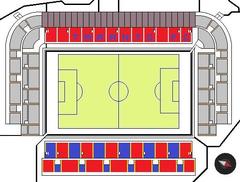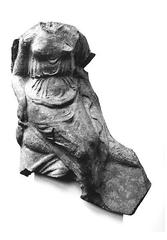
Taranto Cathedral: Visiting Hours, Tickets, and Historical Sites Guide
Date: 03/07/2025
Introduction
Taranto Cathedral, officially the Basilica Cattedrale di San Cataldo, is a monumental testament to southern Italy’s rich and diverse history. Situated in the heart of Taranto’s Città Vecchia (Old Town), this cathedral stands as both a spiritual center dedicated to Saint Catald—Taranto’s patron saint—and a chronicle of architectural evolution, reflecting Early Christian, Byzantine, Norman, Romanesque, and Baroque influences. Whether you are an avid history buff, architecture lover, or a traveler seeking cultural enrichment, visiting Taranto Cathedral offers a journey through centuries of art, devotion, and tradition.
This comprehensive guide provides essential information on visiting hours, tickets, accessibility, and nearby attractions, as well as an in-depth look at the cathedral’s historical and cultural significance. For up-to-date details and additional insights, consult resources such as Ecosistema Taranto, Travel Puglia, and Rough Guides.
Table of Contents
- Introduction
- Historical Overview
- Patron Saint and Local Devotion
- Architectural and Artistic Significance
- Role in Holy Week and Local Traditions
- Multicultural Heritage and Civic Importance
- Pilgrimage and Spiritual Tourism
- Preservation and Community Engagement
- Visiting Information
- Frequently Asked Questions (FAQ)
- Conclusion
- References
Historical Overview
Early Foundations and Paleochristian Origins
Evidence suggests the site has been sacred since antiquity, with Christian worship dating to at least the 5th–7th centuries AD. The original church, likely dedicated to Santa Maria Maddalena, is referenced in early papal correspondence. Beneath the current structure, a 10th-century crypt preserves paleochristian frescoes and columns, some of Greek and Roman origin, testifying to Taranto’s ancient and continuous religious significance (Ecosistema Taranto).
Byzantine, Norman, and Romanesque Transformations
During the 10th century, the cathedral underwent significant Byzantine remodeling under Emperor Nicephorus II Phocas. In the 11th and 12th centuries, Bishop Dragone led the construction of a grand Norman cathedral, transitioning the site from Byzantine to Latin rites. The current Romanesque structure, dating from the late 11th century, features thick stone walls, rounded arches, and spolia—columns and capitals reused from ancient structures. The nave is adorned with historic columns, a medieval mosaic floor created by “Petroius,” and a wooden and gold coffered ceiling (Wikipedia, Ecosistema Taranto).
Baroque Renovation and Later Restorations
The 17th and 18th centuries brought Baroque grandeur: a new façade, ornate portals by Mauro Manieri, gilded ceilings, and elaborate marble inlays. The vestibule houses the ancient baptistery and Renaissance artworks. Successive restorations have preserved the cathedral’s artistic treasures, with recent digital initiatives offering virtual tours (Italy This Way).
The Cappellone di San Cataldo
The Cappellone, or Chapel of San Cataldo, was initially built in 1151 and expanded in the Baroque era to enshrine the relics of Taranto’s patron saint. Its colored marble inlays, sculptures by Giuseppe Sanmartino, and role as the burial place for Taranto’s princes underscore the cathedral’s spiritual and historical prominence.
Patron Saint and Local Devotion
Saint Catald, an Irish bishop shipwrecked near Taranto in the 7th century, is revered for his piety and miracles. His relics, discovered in the 11th century, are believed to protect the city. The annual Festa di San Cataldo in May draws pilgrims and features solemn processions, relic displays, and vibrant celebrations that blend religious and civic traditions (Travel Puglia).
Architectural and Artistic Significance
The cathedral’s Romanesque basilica plan comprises a nave and two aisles, with ancient columns likely repurposed from Greek or Roman ruins. Baroque renovations added gilded altars, stuccoes, and frescoes, especially in the Cappellone di San Cataldo. The crypt houses ancient tombs and relics, while chapels are adorned with marble, semiprecious stones, and artworks by Paolo de Matteis. The combination of spolia, wooden ceilings, and elaborate inlays reflects the region’s complex artistic heritage (Italy This Way, Christiane Directory).
Role in Holy Week and Local Traditions
Taranto Cathedral is central to the city’s Settimana Santa (Holy Week) celebrations, among the most evocative in southern Italy. Ceremonies feature hooded confraternities, traditional music, and centuries-old rituals. The cathedral also anchors Christmas, Easter, and various saints’ feast days, with bells and processions integral to Taranto’s spiritual life (Travel Puglia).
Multicultural Heritage and Civic Importance
Located atop ancient Greek and Roman remains, the cathedral’s art and iconography blend Greek crosses, Romanesque capitals, and Baroque angels, mirroring Taranto’s multicultural past. Beyond religious functions, the cathedral hosts concerts and civic events, reinforcing its status as a community focal point (Travel Puglia).
Pilgrimage and Spiritual Tourism
The cathedral is a destination for pilgrims year-round, particularly during San Cataldo’s feast and Holy Week. Local hospitality includes historic guesthouses and modern hotels in the Old Town. The area is rich with ancient necropolises and street festivals, further immersing visitors in Taranto’s religious heritage (Hikersbay).
Preservation and Community Engagement
Continuous restoration projects protect the cathedral’s interiors, crypt, and relics. Community involvement is high, with educational programs, guided tours, and cultural events fostering appreciation among locals and visitors.
Visiting Information
Location and Access
- Address: Piazza Duomo, Città Vecchia, Taranto
- Accessible via foot from city center or by local buses and taxis; limited parking in Old Town—use public parking in the modern city.
Visiting Hours
- Standard hours: 8:00/8:30 AM–12:00/12:30 PM and 4:00/4:30 PM–7:00 PM daily
- Closed during midday (siesta) and possibly during services or special events
- Check official sources or local tourism offices for updated hours (Rough Guides)
Tickets and Guided Tours
- Entry: Free (donations welcome)
- Guided tours: Available for a small fee, especially during peak seasons or by request; advance booking recommended. Some tours in English (Puglia Paradise)
Accessibility
- The main nave is wheelchair accessible; some areas (crypt, chapels) may have limited access due to steps/uneven flooring. Ramps available at some entrances; contact ahead for specific needs.
Dress Code and Etiquette
- Modest attire required: shoulders and knees covered.
- Remove hats; maintain a respectful silence.
- Photography allowed without flash/tripods except during services or in restricted areas.
Facilities
- No restrooms inside; public facilities nearby.
- Cafés and shops in the surrounding area; local souvenirs available.
Visitor Tips
- Visit early or late in the day to avoid crowds.
- Combine your visit with the Aragonese Castle, Tempio di Poseidone, and Museo Archeologico Nazionale di Taranto (MArTA).
- Consider attending major festivals for a unique experience, but expect larger crowds.
- Learn basic Italian phrases; English is spoken by some guides.
- Dress for the Mediterranean climate; bring sun protection in summer.
Nearby Attractions
- Castello Aragonese: Medieval fortress with guided tours and sea views.
- Tempio di Poseidone: Ancient Greek temple remains.
- Museo Archeologico Nazionale di Taranto (MArTA): Renowned archaeological museum.
Frequently Asked Questions (FAQ)
What are Taranto Cathedral’s visiting hours?
Typically 8:00/8:30 AM–12:00/12:30 PM and 4:00/4:30 PM–7:00 PM. Check locally for updates.
Is there an admission fee?
No, entry is free; donations are appreciated.
Are guided tours available?
Yes, for a small fee and in various languages. Booking recommended.
Is the cathedral accessible for visitors with disabilities?
The main nave is accessible; some areas are not.
Can I take photos inside?
Yes, without flash or tripods; respect restrictions during services.
Conclusion
Taranto Cathedral is a vibrant symbol of faith, culture, and history—a must-see among Taranto’s historical sites. Its layered architecture, spiritual legacy, and central role in local tradition make it an essential stop for any visitor. Plan your trip by checking current visiting hours, consider a guided tour to deepen your understanding, and explore nearby attractions to experience the full richness of Taranto’s heritage.
For the latest updates, download the Audiala app and consult trusted resources like Ecosistema Taranto, Travel Puglia, and Rough Guides.


